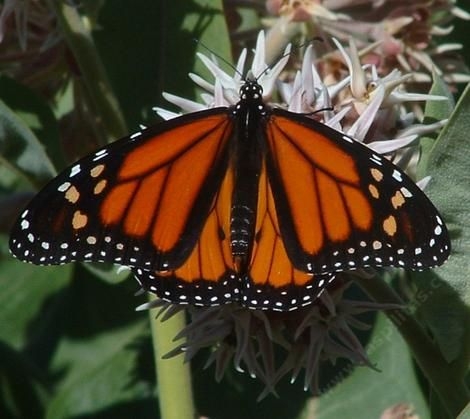By Barbara Richmond, Butte County Master Gardener, August 8, 2014

As they fly northeast, they mate and begin to look for a suitable amount of milkweed upon which to lay their eggs. While these butterflies live on nectar from many plants, their caterpillars can only eat milkweed, an herbaceous perennial.
Monarch butterfly eggs hatch into tiny caterpillars after just five days and begin to feed on milkweed. Around the 17th day, they attach themselves to twigs or stems of the milkweed plant. By the 20th day they have morphed into a chrysalis. On the 28th day, beautiful butterflies begin to emerge. The butterflies that laid these eggs have all died.
The new butterflies begin the next leg of the migration. Unlike their parents, their life span is short: only six to eight weeks. During this time they mate, find milkweed for egg laying, and die soon thereafter. This process is repeated twice more along the way, fulfilling three short-lived generations.
The fourth generation hatches at or near the end of the migration. This generation lives from six to seven months and makes the return journey to the California coast. There the butterflies overwinter to begin a new migration the following spring.
In recent years, this long migration has become harder for Western Monarchs to complete. Their population has dwindled significantly in the last dozen years. Urban sprawl and increased use of herbicides have almost wiped out the milkweed plants these butterflies depend on. Some experts fear the Monarchs are losing their migrating instincts.
In 1997 the estimated population of the Western Monarch was around 1,250,000. In 1998 the estimate was 550,000. A low of 58,000 was estimated in 2009.
A push has been made in recent years for the establishment of butterfly gardens in back yards. It is hoped this will help the Monarchs, as well as other pollinating insects, re-establish their numbers.
There are four milkweed species native to Butte County. One, Asclepius cordifolia, is especially suited to the foothill area. The other three, Asclepius facicularis, Asclepius eriocarpa, and Asclepius speciosa are valley plants. All are drought tolerant.
Milkweed planted in a yard or garden with other drought-resistant pollinator plants will benefit not just Monarchs, but other butterfly and bee species as well. A shallow dish of wet sand to supply water will make such a pollinator garden complete. Be aware that milkweed is toxic to livestock. Although it is unpalatable, they will eat it if other forage is unavailable. It is important to avoid the inclusion of milkweed in prepared feeds and hay.
The 2012 Western Monarch population estimate was 145,000, and the estimate for 2013 increased to 211,275. Perhaps our backyard gardens are making a difference!
For more information, see the Xerces Society for Invertebrate Conservation page on Monarchs at www.xerces.org/monarchs/